
The Macchi C.202 Folgore (Italian "thunderbolt") was an Italian fighter aircraft developed and manufactured by Macchi Aeronautica. It was operated mainly by the Regia Aeronautica (RA; Royal (Italian) Air Force) in and around the Second World War. According to aviation author David Mondey, the Folgore has been considered to be one of the best wartime fighters to serve in large numbers with the Regia Aeronautica.
The C.202 was designed by a team headed by the company's chief of design, Italian aeronautics engineer Mario Castoldi. As per company tradition, Macchi aircraft designed by Mario Castoldi received the "C" letter in their model designation, hence the Folgore is commonly referred to as the C.202 or MC.202. The C.202 was a development of the earlier C.200 Saetta, powered by an Italian-built version of the German Daimler-Benz DB 601Aa engine and featuring a redesigned fuselage for greater streamlining.
During July 1941, the Folgore went into service with the Regia Aeronautica. In combat, it very quickly proved itself to be an effective and deadly dogfighter against its contemporaries. During its service life, the C.202 was deployed on all fronts in which Italy was involved. During late 1941, it commenced offensive operations over Malta and in North Africa, where Italian and German forces were engaged in heavy combat against British and later American operations. The C.202 continued to be used in North Africa as late as mid-1943, by which point the type was withdrawn to support defensive efforts in Sicily and the Italian mainland following their invasion by Allied forces. It also saw limited use on the Eastern Front. Following the 1943 Armistice with Italy, the type was mostly used as a trainer aircraft. The type was also operated by Croatia

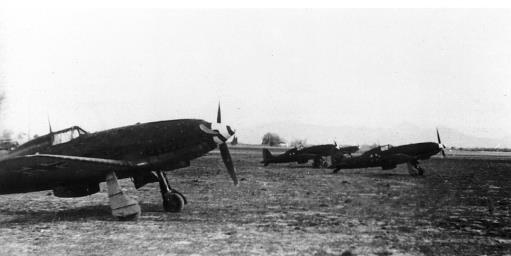
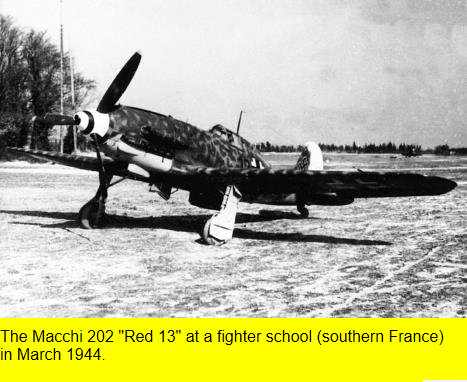
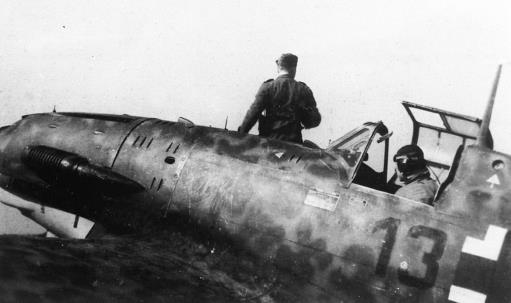
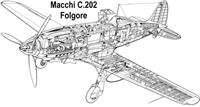
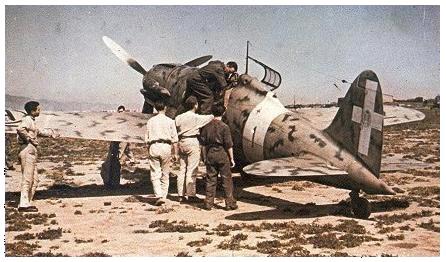









| Type |
Single seat fighter |
| Engine |
1 Alfa Romeo RA.1000 R.C.41-I Monsone with a 3-bladed constant-speed propeller |
| Dimensions |
Length 8,85 m , height 3,49 m , span 10,58 m , wing area 16,82 m2 , Airfoil root NACA 23018 (modified), tip NACA 23009 (modified) |
| Weights |
Empty 2491 kg, loaded , max. take off weight 2930 kg |
| Performance |
Max. speed 600 km/h at 5600 m, cruising speed , range 765 km, endurance , service ceiling 11500 m , climb 18,1 m/sec. |
| Armament |
2 12,7 mm Breda-SAFAT machine guns in the engine cowling - 300/400 rpg, 2 7,7 mm Breda-SAFAT machine guns in the wings 500 rpg, 2 50 kg, 100 kg or 160 kg bombs, 2 100 l drop tanks |
During the 1930s, the Italian military authorities chose to only adopt radial engines to power their aircraft; consequently, during the second half of the 1930s, the Italian aeronautical industry had been sufficiently de-incentivised to the point of completely avoiding the development of more powerful engines based on streamlined liquid-cooled designs, which would become popular abroad. As a result of this preference, Italian aircraft manufacturer Macchi Aeronautica was forced to rely on the ageing Fiat A.74 radial engine to power its C.200 fighter. However, by 1941, the C.200, which was armed with a pair of 12.7 mm machine guns and capable of a maximum speed of 504 km/h , was considered to be obsolete in comparison to competitors in production overseas.
During July 1939, the Regia Aeronautica requested that Reggiane construce a single prototype Re.2000 that was powered by a German Daimler-Benz DB 601Aa, liquid-cooled supercharged inverted V-12 engine rated at 1,175 PS (1,159 hp, 864 kW); this became the Re.2001. At the time, the most powerful reliable Italian inline engine was the 715 kW (960 hp) Isotta Fraschini Asso XI R.C.40, which was designed in 1936. During November 1939, the Italian automotive company Alfa Romeo acquired a license to produce the DB 601Aa as the Alfa-Romeo RA.1000 R.C.41-I Monsone; it was this engine that was to be used in the production of the C.202.
While waiting for domestic production of the engine by Alfa Romeo to ramp up, Aeronautica Macchi decided to import a single DB 601Aa engine; this was initially performed as a private venture without any state support. Macchi chief of design Mario Castoldi commenced work on mating the Macchi C.200 wings, undercarriage, vertical and horizontal tail units to a new fuselage that incorporated the imported DB 601Aa. During January 1940, formal design work on the new fighter commenced and, shortly thereafter, construction began on a single prototype of the design. Castoldi, whose background included working on Schneider Trophy racers design, followed Celestino Rosatelli as the main designer of new fighters for the RA. His new project was robust and small, utilizing a conventional but complex structural arrangement based on his experience with wooden designs, and at the same time paying great attention to its aerodynamics (Castoldi had previously designed the MC.72, the world's fastest aircraft of its time).
On 10 August 1940, less than seven months following the start of design work and two months after Italy's entry into the Second World War, the sole prototype conducted its maiden flight. The prototype differed in some respects from the production aircraft; the headrest fairing incorporated two windows for rear visibility, while production versions replaced this with a narrower, scalloped headrest. The square-sectioned supercharger air intake was replaced by an elongated round sectioned fairing, which was later redesigned to incorporate a dust filter. From the onset of flying trials, it was evident that the C.202 was an advanced design for the era, owing much of its performance to the use of the Daimler Benz DB 601, which represented a departure from the standard practice of using engines of Italian origin
Following its initial flights, the prototype was flown to the Regia Aeronautica's main test airfield at Guidonia, where it reportedly met with an enthusiastic response from test pilots. A speed of 603 km/h was recorded during testing, while an altitude of 5,486 m was attained within the space of six minutes; in addition, little of the favourable manoeuvrability of the earlier C.200 had been lost. Another of its positive attributes was its extremely strong construction, which allowed its pilots to dive the aircraft steeply. The performance figures gathered during these tests indicated that Italy had caught up with both Britain and Germany in the field of fighter airplanes.
As a result of the favourable flight test reports, the C.202 was immediately ordered into production; the first examples (built by Macchi as Serie II) appearing in May 1941. However, the complexity of the structure was not well suited to mass production, and resulted in a relatively limited production rate. According to aviation author Giuseppe Ciampaglia, in comparison to the Bf 109E/F, which was rated at typically requiring 4,500–6,000 man-hours per aircraft to complete, the Macchi routinely needed in excess of 22,000 man-hours. The growth of the C.202 project was slower than that of the rival Re. 2001 effort; but, by employing both mass production techniques and less expensive advanced technologies, the production cost was slightly less than that of the Reggiane Re.2001, (525,000 lire vs 600,000); this latter, the only other DB 601 fighter in mass production, was slower and heavier (2.460/3.240 kg) but had a bigger wing and a more advanced and adaptable structure.
In order to expand production, the Milan-based industrial manufacturer Società Italiana Ernesto Breda was selected to also construct the C.202. Breda would eventually produce the majority of the type. SAI-Ambrosini, based in Passignano sul Trasimeno, also served as another sub-contractor on the C.202, ultimately building around 100 fighters of the type. For some time, supplies of the DB 601 engine continued to be provided directly from Germany in order to supplement Italian production. Throughout the type's production life, manufacturing was near-permanently constrained by the limited availability of the engine.
The Macchi C.202 Folgore was an Italian fighter aircraft, developed from the earlier C.200 Saetta; its principal difference was its use of an Italian-built version of the German Daimler-Benz DB 601Aa engine and the adoption of a revised streamlined fuselage. Both the wing and fuselage structures were of a conventional metal design, having a single vertical tail with two elevators, and a wing of relatively conventional design with two main spars and 23 ribs. The ailerons, elevators and rudder were metal structures with fabric covering. Apart from the ailerons, the entire trailing edge of the wing was dominated by a pair of all metal split flaps. The undercarriage was of a standard design; the two widely set hydraulically-actuated main gears retracted inwardly into recesses set into the wing, while the tail wheel was non-retractable.
The fuselage of the C.202 was a semi-monocoque shell, comprising four light-alloy beams, complete with longerons and ovoidal bulkheads. It was significantly streamlined over the preceding C.200 to increase performance by reducing the parasitic drag encountered. The forward section housed both the main armament and the Alfa Romeo RA.1000 R.C.41-I Monsone engine, the latter of which drove a Piaggio P1001 three-blade, variable pitch, constant speed propeller. As with the C.200, to counteract the torque of the engine, Castoldi extended the left wing by 21 cm ; this meant that the left wing developed more lift, offsetting the tendency of the aircraft to roll to the left due to the rotation of the propeller. The wing was a bi-longeron structure, which was attached to the fuselage center section via steel forgings; it was fitted with flaps that were both statically and dynamically balanced.
The main coolant radiator was housed in a rectangular fairing under the fuselage beneath the cockpit, and the oil cooler was placed under the nose within a streamlined, rectangular housing. From the cockpit aft, the fuselage was formed into a round monocoque structure; the aft fuselage tapered into the tail and contained the radio, oxygen and flight control mechanisms. The canopy was hinged on the starboard base and opened sideways. Behind the canopy, the pilot's headrest was fixed to a triangular turn-over pylon which was covered by a streamlined, tapered fairing. This fairing was shaped into an inverted 'T' which enabled the pilot to have a reasonable field of view to the rear. The unpressurised cockpit had an armor plate fitted behind the armored seat for protection. While early C.202s had a very short "stub" radio mast projecting from the fairing, most used a tall, slim mast.
Situated behind the engine and under the 12.7 mm ammunition boxes there was a single 270 L fuel tank; all tanks were of the self-sealing variety. Another 80 L fuel tank was placed behind the pilot, along with a pair of additional tanks, each with a capacity of 40 L , being housed in the wing roots; the total fuel capacity was 430 L Jettisonable tanks, containing either 22 or 33 gallons of fuel, could be installed upon some of the later built aircraft.
Initially, all the armament was fitted within the nose of the Macchi. Ammunition carried was up to 800 rounds (standard: 700 rounds) An additional pair of Breda 7.7 mm machine guns was fitted in the wings in the VII series onward, but these, along with 1,000 rounds of ammunition, added 100 kg to the aircraft's weight and were typically removed by pilots to save weight, since they were relatively ineffective against most enemy aircraft in 1942. A synchronizing unit allowed the nose guns to fire through the propeller disk, but with a 25% loss in ROF (Rate of Fire). A "San Giorgio" reflector gun sight was fitted.
On 21 August 1941, Tenente Giulio Reiner, one of the most skillful and experienced pilots of 9° Gruppo, flew the "military control flight" in Lonate Pozzolo, The Ufficio tecnico (Technical Bureau) recorded the maximum speed of 1,078.27 km/h in the Folgore in a vertical dive, with 5.8 G. forces while pulling out of the dive. Ingegner Mario Castoldi, the designer of the 202 questioned whether Reiner had properly flown the test. In fact, during the vertical dive, Reiner had to face very strong vibrations throughout the airframe and in the control stick, while the flying controls were locked and the propeller blades were jammed at maximum pitch. The clean aerodynamics offered by the inline engine permitted dive speeds high enough for pilots to encounter the then-unknown phenomenon of compressibility.
The empty weight of the new C.202 (approximately 2,350 kg) gradually increased throughout production, and due to the thickness of metal used it was also comparatively heavy, yet this class of aircraft was still considered lightweight compared to other contemporary fighter designs. The Macchi's mass was around 300 kg higher than the comparable Bf 109E German fighter, consequently, the power-to-weight ratio was considerably lower while wing loading was higher. The relatively high diving speed of the type has been attributed to the exceptionally clean design of its fuselage.
During 1940, the Folgore was put into production using imported DB 601Aa engines, while Alfa Romeo set up production of the engine under license as the RA.1000 R.C.41-I Monsone (Monsoon). Due to initial delays in engine production, Macchi resorted to completing some C.202 airframes as C.200s, powered by Fiat-built radial engines. Nevertheless, by late 1942, Folgores outnumbered all other fighter aircraft in the Regia Aeronautica.
By the signing of the 1943 Armistice with Italy, there were only 186 Folgores remaining, of which roughly 100 aircraft were still considered to be in a serviceable condition. Several C.202s served with the Allied-aligned Italian Co-Belligerent Air Force, and some of these were subsequently reconstructed into C.205s or C.202/205 with the Veltro's engine. Others served as trainers in the Axis-aligned Aeronautica Nazionale Repubblicana (National Republican Air Force) of the Italian Social Republic (RSI) and the Luftwaffe
In Croatian service
About 20–22 Macchi C.202s were flown by Croatia, who typically operated them in the interceptor role against Allied bombers. During 1944, the Air Force of the Independent State of Croatia, Zrakoplovstvo Nezavisne Države Hrvatske (ZNDH), received several batches of C.202s. During January, eight brand-new Folgore fighters arrived at Zagreb's Lucko airfield. Two weeks later, another four aircraft arrived; one of these was reportedly lost during a test-flight. The first batch of 16 "Folgores" delivered to the ZNDH was from the XII series, built by Breda following the German occupation of Northern Italy. These fighters equipped Kroat. JGr 1 and retained their Luftwaffe markings whilst in service with the unit. During 1944, the Croatian Air Force Legion (HZL) fighter squadron had returned to Croatia from service on the Eastern Front. Upon its return, the HZL was redesignated Kroat. JGr 1, while its operational fighter squadron was redesignated 2./(Kroat.)JGr; this unit was equipped with Macchis. A second training / operational conversion squadron was also formed, designated 3./(Kroat.)JGr and equipped with Fiat G.50, Macchi C.200 and Fiat CR.42 fighters. During March 1944, they were scrambled for the first time against an American raid west of Zagreb, but combat was avoided: Croatian Macchi pilots had been initially instructed to attack only those aircraft which had already been damaged or had become separated from their main formations.
On 24 April 1944, the first confirmed air victory was claimed by Unteroffizier Leopold Hrastovcan against an American B-24 that was shot down near the village of Zapresic (Zagorje). According to some sources, during these first sorties, Croat C.202s claimed between 11 and 16 aerial victories, but only three further were confirmed. During May 1944, the Croatians received four C.202s from the Luftwaffe in Niš, Serbia; during the ferry flight, a single Macchi crash landed near Zemun airfield. Around June 1944, the Croat unit received the last six Folgore and three or four brand new Macchi C.205s. Irrespective of the Croatian Air Force Legion having been disbanded at the end of July, after which it was replaced by the Croatian Air Force Group (HZS), the fighters themselves remained at Borovo. During a period of intensive activity over the summer, the squadron had claimed some 20 Allied aircraft shot down. At the end of the summer, those C.202s that were still in a flight-worthy condition, based in Borovo, were used by Croatian cadets for training purposes. During September 1944, Luftwaffe pilots flew all of the remaining airworthy Folgores to Borongaj, where they were used only for training.












